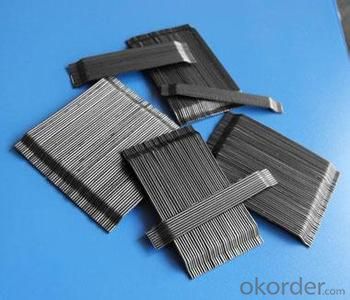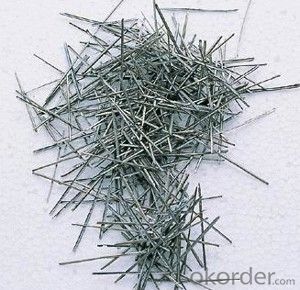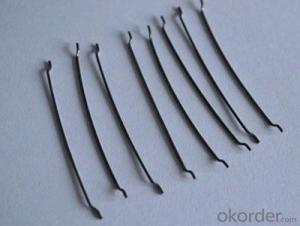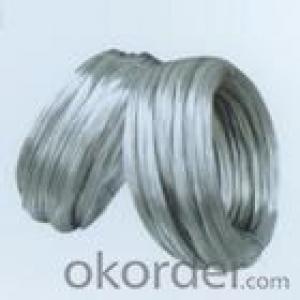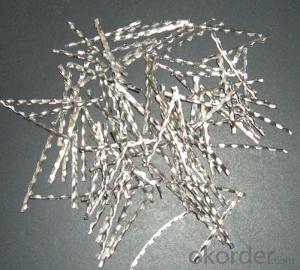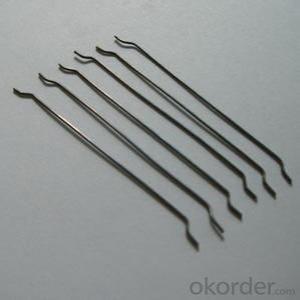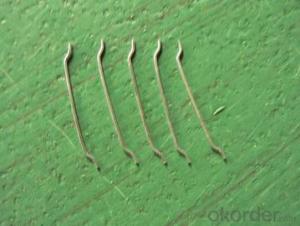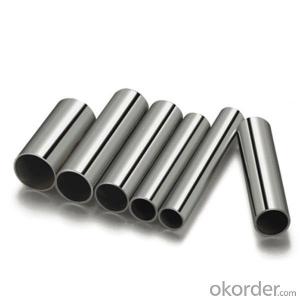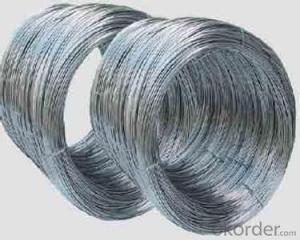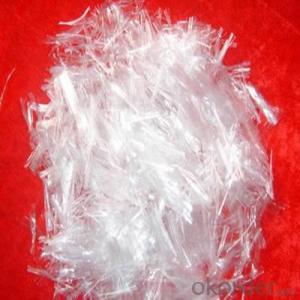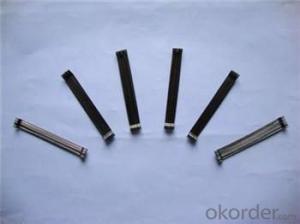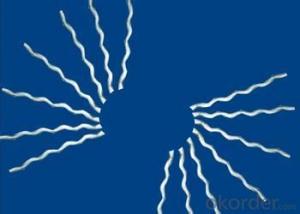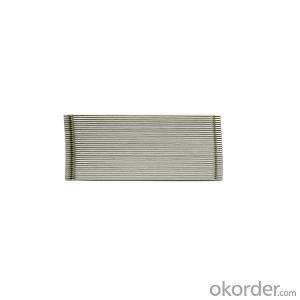Glued low Steel Fiber From Company CNBM China
- Loading Port:
- Tianjin
- Payment Terms:
- TT OR LC
- Min Order Qty:
- 1 m.t.
- Supply Capability:
- 600 m.t./month
OKorder Service Pledge
Quality Product, Order Online Tracking, Timely Delivery
OKorder Financial Service
Credit Rating, Credit Services, Credit Purchasing
You Might Also Like
Quick Details
Place of Origin: Tianjin, China (Mainland)
Model Number: 0.55 mm
Material: Steel
Production Process: Cold drawn
Lengh: 35
Type: 1
Compressive Strength: >1200MPa
Aspect ratio: 63
Standard: ASTM A820M-11
Section Shape: Circular
Application: Concrete Reinforcement
Packaging & Delivery
| Packaging Details: | 20 kg/Bag,50 bags/Pallet or 1,000kg/ Bulk Bag |
|---|---|
| Delivery Detail: | 1 Month |
Product Description
| Diameter | 0.55 mm | ||
| Length | 35 mm | ||
| Aspect Ratio | 63 | ||
| Tensile strength | 1200 MPa | ||
| Type | Cold drawn Steel Fiber | ||
| End | Hooked-end Steel Fiber | ||
| Glued/Loose | Glued Steel Fiber | ||
| Bending Angle | 45°(min.30°) | ||
| Usage & Performance | Floor:Trafficked areas and Industrial floors | ||
| Shotcrete :Slope stabilization and Final lining | |||
| Precast concrete:Pipe and Railway sleepers | |||
| Packing | Standard Export Pallet Packing | Bag Packing | 20 kg/Bag,50 bags/Pallet |
| Bulk Packing | 1,000kg/ Bulk Bag | ||
| Loading Quantity | 20’GP | 20-25 Tonne/Tonnes | |
| 40’GP | 25-27 Tonne/Tonnes | ||
| 40’HQ | 25-27 Tonne/Tonnes | ||
| MOQ | 1 kg for trial order | ||
| Supply Ability | 10,000 Tonne/Tonnes per Year | ||
| Payment Terms | T/T or L/C at sight | ||
| Delivery Time | Within 15 days after receiving deposit or original L/C at sight | ||
| Certification | ISO9001:2000, CE, | ||
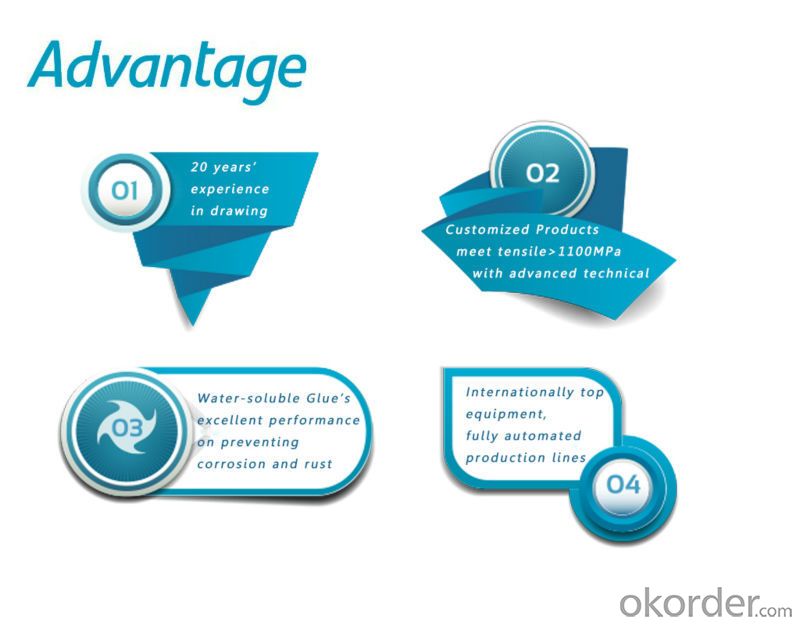
| Product | Diameter (mm) | Length (mm) | Aspect Ratio | Type | Packing |
| G-6030 | 0.5 | 30 | 60 | Glued | 20 kg/Bag, or 1,000kg/ Bulk Bag |
| G-6535 | 0.55 | 35 | 65 | Glued | 20 kg/Bag, or 1,000kg/ Bulk Bag |
| G-6035 | 0.6 | 35 | 60 | Glued | 20 kg/Bag, or 1,000kg/ Bulk Bag |
| G-8060 | 0.75 | 60 | 80 | Glued | 20 kg/Bag, 50 bags/Pallet |
| G-6060 | 0.9 | 60 | 60 | Glued | 20 kg/Bag, 50 bags/Pallet |
| G-6030 | 0.5 | 30 | 60 | Loose | 20 kg/Bag, or 1,000kg/ Bulk Bag |
| G-6535 | 0.55 | 35 | 65 | Loose | 20 kg/Bag, or 1,000kg/ Bulk Bag |
| G-6035 | 0.6 | 35 | 60 | Loose | 20 kg/Bag, or 1,000kg/ Bulk Bag |
| G-8060 | 0.75 | 60 | 80 | Loose | 20 kg/Bag, 50 bags/Pallet |
| G-6060 | 0.9 | 60 | 60 | Loose | 20 kg/Bag, 50 bags/Pallet |
- Q: Can melt extract stainless steel fiber be used in sports field pavements?
- Yes, melt extract stainless steel fiber can be used in sports field pavements. Stainless steel fibers are known for their high strength and durability, making them an excellent choice for applications that require resistance to wear and heavy traffic, such as sports field pavements. These fibers can improve the overall performance and lifespan of the pavement by enhancing its toughness, crack resistance, and fatigue resistance. Additionally, the corrosion resistance of stainless steel ensures that the fibers will not deteriorate over time, even in harsh weather conditions. Overall, using melt extract stainless steel fiber in sports field pavements can help create a more robust and long-lasting surface that can withstand the rigorous demands of sports activities.
- Q: Can melt extract stainless steel fiber be used in the construction of bridge decks?
- Yes, melt extract stainless steel fiber can be used in the construction of bridge decks. These fibers enhance the strength and durability of the concrete used in bridge decks, making them more resistant to cracking, shrinking, and corrosion. Additionally, they provide increased load-bearing capacity, improved resistance to impact and fatigue, and enhanced fire resistance. Thus, incorporating melt extract stainless steel fiber in bridge deck construction can significantly improve the overall performance and longevity of the structure.
- Q: How does melt extract stainless steel fiber enhance the durability of concrete structures?
- The durability of concrete structures is greatly improved by the addition of melt extract stainless steel fiber. These fibers provide various advantages that contribute to the overall strength and longevity of the structure. To begin with, melt extract stainless steel fibers play a crucial role in enhancing the resistance to cracking in concrete. Acting as reinforcement, these fibers distribute stress and minimize the formation of shrinkage cracks. This is especially important in environments with extreme temperature variations or heavy loads, as it prevents the development of cracks that could compromise the structure's integrity. Furthermore, stainless steel fibers enhance the toughness and impact resistance of concrete. By dispersing throughout the concrete matrix, they create a three-dimensional network of reinforcement that improves the material's ability to absorb and distribute energy upon impact. This increased toughness prevents cracks from spreading, making the structure more durable and resistant to damage from external forces. Another significant advantage of melt extract stainless steel fibers is their ability to enhance the resistance to corrosion in concrete structures. Stainless steel is naturally resistant to rust and oxidation, even in harsh environments. By incorporating these fibers into the concrete mix, an additional layer of protection against corrosion is provided, thereby increasing the lifespan of the structure and reducing the need for maintenance and repair. Additionally, the use of melt extract stainless steel fibers can improve the fire resistance of concrete structures. Due to its high melting point, stainless steel helps delay structural failure under high temperatures when added to concrete. This is particularly important in buildings and structures where fire safety is a critical concern. In conclusion, the incorporation of melt extract stainless steel fibers significantly enhances the durability of concrete structures. By improving resistance to cracking, increasing toughness and impact resistance, enhancing corrosion resistance, and improving fire resistance, these fibers ensure that the concrete structure remains strong and intact for a longer period, reducing the need for repairs and replacements and ultimately saving costs.
- Q: What is the effect of melt extract stainless steel fiber on the modulus of creep of concrete?
- The inclusion of melt extract stainless steel fibers in concrete has a positive effect on the modulus of creep of the material. Stainless steel fibers are known for their high tensile strength, corrosion resistance, and durability. When these fibers are added to concrete, they act as reinforcement, enhancing its overall mechanical properties. The modulus of creep refers to the material's ability to resist deformation over time under a constant load. By adding stainless steel fibers, the concrete's resistance to creep is improved, as the fibers help to distribute the load and reduce internal stresses within the material. This leads to a decrease in the rate of creep and a higher modulus of creep. The presence of melt extract stainless steel fibers also enhances the overall ductility of the concrete. This means that the material can withstand greater deformation before failure, resulting in improved structural stability and performance. This is particularly beneficial in applications where the concrete is subjected to sustained loads or temperature variations, as it reduces the risk of long-term deformation and potential structural failure. Overall, the effect of melt extract stainless steel fibers on the modulus of creep of concrete is a positive one. Their addition improves the material's resistance to deformation over time, enhances its mechanical properties, and increases its overall durability.
- Q: What is the optimal dosage of melt extract stainless steel fiber in concrete?
- The optimal dosage of melt extract stainless steel fiber in concrete depends on various factors such as the specific application, desired performance characteristics, and the type of concrete mix being used. It is recommended to consult with a structural engineer or a concrete expert to determine the appropriate dosage that will meet the specific requirements of the project.
- Q: What is the effect of melt extract stainless steel fiber on the modulus of porosity of concrete?
- The melt extract stainless steel fiber has a significant effect on the modulus of porosity of concrete. When stainless steel fibers are added to the concrete mix, they help to reduce the overall porosity of the material. This is due to the unique properties of stainless steel fibers, such as their high tensile strength and corrosion resistance. The addition of melt extract stainless steel fibers improves the overall durability and strength of the concrete by filling in the voids and reducing the porosity. This results in a denser concrete matrix with a lower modulus of porosity. The reduced porosity enhances the concrete's resistance to water absorption, chemical attack, and freeze-thaw cycles. Furthermore, the stainless steel fibers also enhance the crack resistance and ductility of the concrete. They act as reinforcement, providing additional strength and preventing the propagation of cracks. This contributes to a higher modulus of elasticity, which is a measure of a material's ability to deform under stress and return to its original shape. Overall, the addition of melt extract stainless steel fiber to concrete has a positive effect on the modulus of porosity. It improves the durability, strength, and crack resistance of the concrete, making it a preferred choice for various construction applications where high-performance and long-lasting concrete is required.
- Q: Does melt extract stainless steel fiber affect the workability of concrete?
- Yes, melt extract stainless steel fiber can affect the workability of concrete. When added to the concrete mix, the stainless steel fibers can increase the viscosity and stiffness of the mixture, making it more difficult to work with. This can result in a decrease in the workability of the concrete, making it less fluid and harder to shape or mold. However, the extent of this impact will depend on the dosage and length of the stainless steel fibers used, as well as the specific requirements of the concrete application.
- Q: What is the effect of melt extract stainless steel fiber on the impact strength of shotcrete?
- The addition of melt extract stainless steel fiber to shotcrete generally improves its impact strength. This is because the fiber reinforces the shotcrete matrix, enhancing its ability to resist cracking and withstand impact forces.
- Q: How does melt extract stainless steel fiber improve the durability of nuclear power plant concrete?
- Melt extract stainless steel fiber improves the durability of nuclear power plant concrete by increasing its resistance to cracking, reinforcing its structural integrity, and enhancing its resistance to corrosion and radiation.
- Q: Can melt extract stainless steel fiber be used in nuclear power plant applications?
- Yes, melt extract stainless steel fiber can be used in nuclear power plant applications. Stainless steel fibers have excellent corrosion resistance, high temperature resistance, and good mechanical properties. These characteristics make them suitable for various critical applications in nuclear power plants, such as reinforcing concrete structures, improving the thermal and mechanical properties of concrete, and enhancing the overall structural integrity of the plant. Additionally, stainless steel fibers can provide enhanced resistance to radiation damage, which is crucial in the nuclear power plant environment. Therefore, melt extract stainless steel fiber is a reliable and effective material for use in nuclear power plant applications.
Send your message to us
Glued low Steel Fiber From Company CNBM China
- Loading Port:
- Tianjin
- Payment Terms:
- TT OR LC
- Min Order Qty:
- 1 m.t.
- Supply Capability:
- 600 m.t./month
OKorder Service Pledge
Quality Product, Order Online Tracking, Timely Delivery
OKorder Financial Service
Credit Rating, Credit Services, Credit Purchasing
Similar products
Hot products
Hot Searches
Related keywords


